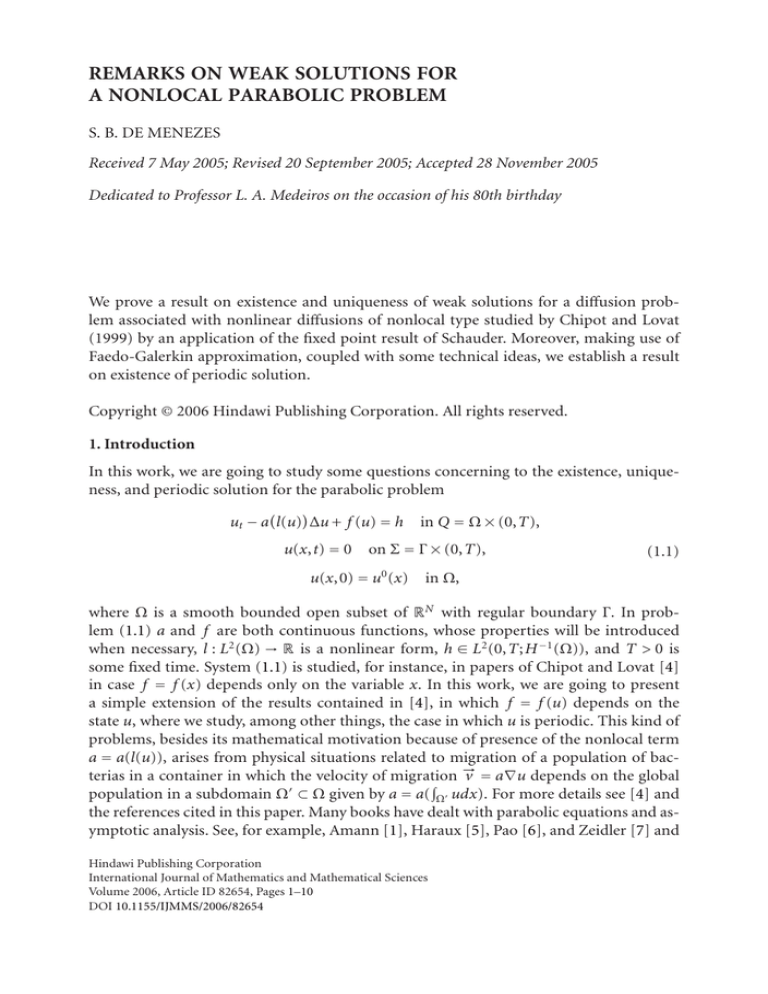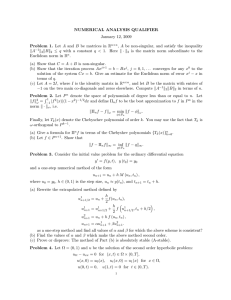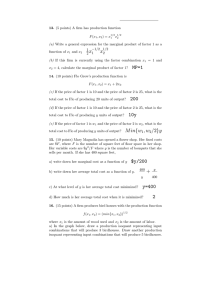
REMARKS ON WEAK SOLUTIONS FOR
A NONLOCAL PARABOLIC PROBLEM
S. B. DE MENEZES
Received 7 May 2005; Revised 20 September 2005; Accepted 28 November 2005
Dedicated to Professor L. A. Medeiros on the occasion of his 80th birthday
We prove a result on existence and uniqueness of weak solutions for a diffusion problem associated with nonlinear diffusions of nonlocal type studied by Chipot and Lovat
(1999) by an application of the fixed point result of Schauder. Moreover, making use of
Faedo-Galerkin approximation, coupled with some technical ideas, we establish a result
on existence of periodic solution.
Copyright © 2006 Hindawi Publishing Corporation. All rights reserved.
1. Introduction
In this work, we are going to study some questions concerning to the existence, uniqueness, and periodic solution for the parabolic problem
ut − a l(u) Δu + f (u) = h
in Q = Ω × (0,T),
u(x,t) = 0 on Σ = Γ × (0,T),
(1.1)
u(x,0) = u (x) in Ω,
0
where Ω is a smooth bounded open subset of RN with regular boundary Γ. In problem (1.1) a and f are both continuous functions, whose properties will be introduced
when necessary, l : L2 (Ω) → R is a nonlinear form, h ∈ L2 (0,T;H −1 (Ω)), and T > 0 is
some fixed time. System (1.1) is studied, for instance, in papers of Chipot and Lovat [4]
in case f = f (x) depends only on the variable x. In this work, we are going to present
a simple extension of the results contained in [4], in which f = f (u) depends on the
state u, where we study, among other things, the case in which u is periodic. This kind of
problems, besides its mathematical motivation because of presence of the nonlocal term
a = a(l(u)), arises from physical situations related to migration of a population of bac−
→
v = a∇u depends on the global
terias in a container in which the velocity of migration
population in a subdomain Ω ⊂ Ω given by a = a( Ω udx). For more details see [4] and
the references cited in this paper. Many books have dealt with parabolic equations and asymptotic analysis. See, for example, Amann [1], Haraux [5], Pao [6], and Zeidler [7] and
Hindawi Publishing Corporation
International Journal of Mathematics and Mathematical Sciences
Volume 2006, Article ID 82654, Pages 1–10
DOI 10.1155/IJMMS/2006/82654
2
Remarks on weak solutions for a nonlocal parabolic problem
the references therein. However, because of the nonlocal term a we cannot, in the present
problem, make a direct adaptation of the classical techniques. In view of this we have to
appeal to another device in order to obtain results similar to those in which appear only
local terms. In particular, our approach rests heavily on the ideas developed by Chipot
and Lovat [4]. This work is organized as follows. In Section 2, we prove basic results on
existence and uniqueness of weak solution for problem (1.1). The methodology of the
proof of our results is based on the fixed point argument. Finally, in Section 3, we will
prove the existence and uniqueness of periodic weak solution for problem (1.1). We use
Faedo-Galerkin method and Brower fixed point theorem plus also some technical ideas.
2. Results on existence and uniqueness
The first object of this work is to prove existence and uniqueness for the problem (1.1).
In fact, concerning problem (1.1), we will suppose that a : R → R is continuous and that
for some constants m, M,
0 < m ≤ a(ξ) ≤ M,
∀ξ ∈ R,
(2.1)
2
l : L (Ω) −→ R is a continuous nonlinear form,
(2.2)
that is, there is g ∈ L2 (Ω) such that l(u) = lg (u) = Ω g(x)u(x)dx for all u ∈ L2 (Ω) and
f : R → R is a Lipschitz continuous function, that is, there exists γ > 0 such that
f (s) − f (t) ≤ γ|s − t |,
∀s,t ∈ R.
(2.3)
Moreover assume that f (0) = 0, f (0) exists.
In this section, we present some notation that will be used throughout this work. By
·, ·
we will represent the duality pairing between X and X , X being the topological
dual of the space X, and by C (sometimes C1 ,C2 ,...) we denote various positive constants.
We represent by H m (Ω) the usual Sobolev space of order m, by H0m (Ω) the closure of
C0∞ (Ω) in H m (Ω), and by L2 (Ω) the class of square Lebesgue integrable real functions.
In particular, H01 (Ω) has inner product ((·, ·)) and norm · given by ((u,v)) = Ω ∇u ·
∇v dx; u2 = Ω |∇u|2 dx. For the Hilbert space L2 (Ω) we represent
its inner and norm,
respectively, by (·, ·) and | · |, defined by (u,v) = Ω uv dx; |u|2 = Ω |u|2 dx. We have our
first result.
Theorem 2.1. If (2.1)–(2.3) hold, then for
u0 ∈ L2 (Ω),
h ∈ L2 0,T,H −1 (Ω)
(2.4)
there exists a function u such that
ut ∈ L2 0,T,H −1 (Ω) ,
u ∈ L2 0,T,H01 (Ω) ∩ C [0,T],L2 (Ω) ,
0
d
(u,v) + a l(u)
dt
u(x,0) = u ,
Ω
∇u · ∇v dx +
(2.5)
(2.6)
Ω
f (u)v dx = h,v
,
for all v ∈ H01 (Ω), where (2.7) must be understood as an equality in Ᏸ (0,T).
(2.7)
S. B. de Menezes 3
Proof. We argue using the Schauder fixed point theorem. For that purpose, consider w ∈
L2 (0,T;L2 (Ω)) and u = N(w) the unique solution to “linearized” problem
u ∈ L2 0,T,H01 (Ω) ∩ C [0,T],L2 (Ω) ,
ut ∈ L2 0,T,H −1 (Ω) ,
0
d
(u,v) + a l(w)
dt
u(x,0) = u ,
Ω
(2.9)
∇u · ∇v dx +
Ω
(2.8)
b(x,t,w)uv dx = h,v
,
(2.10)
in Ᏸ (0,T) for all v ∈ H01 (Ω).
Here b : Ω × R+ × R → R is defined by
⎧
⎪
f (η)
⎪
⎨
b(x,t,η) = ⎪ η
⎪
⎩ f (0)
for η = 0,
(2.11)
for η = 0.
We note that the mapping
t −→ l(w)
(2.12)
is measurable, and due to (2.1)–(2.3), so is
t −→ a l(w) .
(2.13)
We also note that a(l(w)) ∈ L∞ (0,T), and b(x,t,η) is continuous, a.e. (x,t) ∈ Ω × R+ , and
measurable for all η ∈ R and
b(x,t,η) ≤ C
a.e. (x,t) ∈ Ω × R+ , ∀η ∈ R.
(2.14)
We know that such a u = N(w) exists (see, e.g., [3]). Thus we would like to show that the
mapping
w −→ N(w)
(2.15)
from L2 (0,T;L2 (Ω)) into itself has a fixed point—this will be clearly a solution to our
problem.
First let us remark that
ut − a l(w) u + b(x,t,w)u = h
in L2 0,T;H −1 (Ω) ,
(2.16)
and thus for every v ∈ L2 (0,T;H01 (Ω)),
ut ,v + a l(w) (∇u, ∇v) + b(x,t,w)(u,v) = h,v
a.e. t ∈ (0,T).
(2.17)
Taking v = u in (2.17), and in view of (2.1) and (2.14), one gets
1 d
u(t)2 + mu(t)2 ≤ C u(t)2 + u(t)|h|H −1 (Ω) .
2 dt
(2.18)
4
Remarks on weak solutions for a nonlocal parabolic problem
Applying Young’s inequality, we obtain
1 d
u(t)2 + mu(t)2 ≤ C u(t)2 + m u(t)2 + 1 |h|2 −1 ,
2 dt
2
2m H (Ω)
(2.19)
1 d
u(t)2 + m u(t)2 ≤ C u(t)2 + 1 |h|2 −1 .
2 dt
2
2m H (Ω)
(2.20)
that is,
Integrating it over (0,t) and employing Gronwall’s lemma, we obtain
|u|L2 (0,T;H01 (Ω)) ≤ C,
|u|L2 (0,T;L2 (Ω)) ≤ C.
(2.21)
Setting
B = v ∈ L2 0,T;L2 (Ω) | |v|L2 (0,T;L2 (Ω)) ≤ C ,
(2.22)
it follows that w → u = N(w) is a mapping from B into itself. The arguments above show
that when w lies in a bounded set B of L2 (0,T;L2 (Ω)), u = N(w) also lies in a bounded
set of L2 (0,T;L2 (Ω)). We have to show that N(B) is relatively compact in L2 (0,T;L2 (Ω)).
Indeed, going back to (2.10), we have
u t L2 (0,T;H −1 (Ω))
≤ C.
(2.23)
Then u belongs to W(0,T,H01 (Ω),H −1 (Ω)). We recall that
W(0,T,X,Y ) = v ∈ L2 (0,T;X) | vt ∈ L2 (0,T;Y ) .
(2.24)
Thus, the compactness of N is a consequence of the compactness of the embedding of
W(0,T,H01 (Ω),H −1 (Ω)) into L2 (0,T;L2 (Ω)) (Aubin-Lions compactness result). In order
to be able to apply the Schauder fixed point theorem, we now just need to prove that N is
continuous from B into itself. For that let (wn ) be a sequence in B such that
wn −→ w
in L2 0,T;L2 (Ω) .
(2.25)
Set un = N(wn ). From (2.25) we derive that
l wn −→ l(w) in L2 (0,T).
(2.26)
By the estimates above and Aubin-Lions compactness result we can find u∞ ∈ W(0,T,
H01 (Ω),H −1 (Ω)) and a subsequence from n that we will label also n such that
un
u∞
un −→ u∞
weakly in W 0,T,H01 (Ω),H −1 (Ω) ,
2
2
strongly in L 0,T;L (Ω) ,
l wn −→ l(w) a.e. t ∈ (0,T).
(2.27)
(2.28)
(2.29)
S. B. de Menezes 5
By continuity of a we obtain
a l wn
−→ a l(w)
a.e. t ∈ (0,T).
(2.30)
From (2.10) we have that
−
T
0
Ω
un vϕ (t)dx dt +
T
+
Ω
0
T
Ω
0
a l wn ∇un · ∇vϕ(t)dx dt
b x,t,wn un vϕ(t)dx dt =
T
0
(2.31)
h,v ϕ(t)dt,
for any ϕ ∈ Ᏸ(0,T), v ∈ H01 (Ω).
By the Lebesgue’s dominated convergence theorem we have
∂v
ϕ(t)b x,t,wn v −→ ϕ(t)b(x,t,w)v,
ϕ(t)a l wn
∂xi
∂v
−→ ϕ(t)a l(w)
,
(2.32)
∂xi
in L2 (0,T;L2 (Ω)). Taking limit in both sides of (2.31), we obtain that u∞ satisfies (2.8)
and (2.10). By (2.28) one can assume without loss of generality that
un (t) −→ u∞ (t) in L2 (Ω), a.e. t ∈ (0,T).
(2.33)
u∞ (0) = u0 .
(2.34)
Thus
Then by the uniqueness of the solution to (2.8)–(2.10) we have that u∞ = u. Since any
subsequence of un has the same limit,
in L2 0,T;L2 (Ω) ,
un = N wn −→ u = N(w)
(2.35)
which concludes the proof of Theorem 2.1.
Next, we will prove the following result.
Theorem 2.2. Assume that a is Lipschitz continuous in the sense that there exists a constant
A such that
a(t) − a(t ) ≤ A|t − t |,
∀t,t ∈ R.
(2.36)
Then under the assumptions of Theorem 2.1, the problem (1.1) has a unique solution.
Proof. Let us denote by u1 and u2 two solutions of (1.1). Thus
d
u1 − u2 ,v + a l u1
dt
×
Ω
∇u2 · ∇v dx +
Ω
Ω
∇u1 · ∇v dx − a l u2
f u1 − f u2 v dx = 0.
(2.37)
6
Remarks on weak solutions for a nonlocal parabolic problem
From (2.3) we obtain
d
u1 − u2 ,v + a l u1
dt
∇ u1 − u2 · ∇v dx
Ω
≤ (a l u2 − a l u1
∇u2 · ∇v dx + γ u1 − u2 v dx.
Ω
(2.38)
Ω
Taking v = (u1 − u2 )(t), for a.e. t, one gets
1 d
u 1 − u 2 2 + a l u 1 u 1 − u 2 2
2 dt
≤ a l u 2 − a l u 1 Ω
∇u2 ∇ u1 − u2 dx + γu1 − u2 2 .
(2.39)
So by the Cauchy-Schwarz inequality and by using (2.1)–(2.2) and (2.36), one gets
1 d
u 1 − u 2 2 + m u 1 − u 2 2
2 dt
2
≤ Al u2 − l u1 u2 u1 − u2 + γu1 − u2 (2.40)
2
≤ C u 1 − u 2 u 2 u 1 − u 2 + γ u 1 − u 2 .
Then, applying Young’s inequality, we obtain
1 d
u 1 − u 2 2 + m u 1 − u 2 2
2 dt
2
2 2
2
1 2
m
≤ u 1 − u 2 +
C u 2 u 1 − u 2 + γ u 1 − u 2 2
2m
2
2
m
C u2 2 + γ u1 − u2 2 ,
= u 1 − u 2 +
2
2m
(2.41)
d
u1 − u2 ≤ ζ(t)u1 − u2 2 ,
dt
(2.42)
which gives
where the function ζ(t) belongs to L1 (0,T). So this reads after multiplication by
exp −
d
exp −
dt
t
0
t
0
ζ(s)ds ,
2
ζ(s)ds u1 − u2
≤ 0.
(2.43)
Since this last function is nonincreasing and vanishes at 0 (u1 (0) = u2 (0)), the result fol
lows.
S. B. de Menezes 7
3. Periodic solution
The second object of this work is to show the existence of periodic solution of problem
(1.1). For this purpose, in addition to (2.1)–(2.3), we assume that
mλ1 − 2γ > 0,
(3.1)
with λ1 the first eigenvalue of (−,H01 (Ω)). We make use of Faedo-Galerkin approximation and Brower fixed point theorem. The result on the periodic solution is given by the
following theorem.
Theorem 3.1. Under the assumptions of Theorem 2.2, assume that (3.1) holds. If h ∈ L2
(0,T,H −1 (Ω)), then there exists a unique solution u of the periodic problem
d
(u,v) + a l(u)
dt
Ω
ut ∈ L2 0,T,H −1 (Ω) ,
u ∈ L2 0,T,H01 (Ω) ∩ C [0,T],L2 (Ω) ,
∇u · ∇v dx +
Ω
f (u)v dx = h,v
,
(3.2)
for all v ∈ H01 (Ω), in the sense of Ᏸ (0,T),
u(0) = u(T) in L2 (Ω).
(3.3)
Proof. We employ the Faedo-Galerkin method. Let (ω j ) j ∈N be a Hilbertian basis of
H01 (Ω) (cf. Brezis [2]). Represent by V j the subspace of H01 (Ω) generated by {ω1 ,...,ω j }
and let us consider the approximate problem given by
uj ∈ Vj,
∇u j , ∇v + f u j ,v = h,v ,
uj ,v + a l u j
u j (0) = u0j −→ u0
(3.4)
∀v ∈ V j ,
strongly in L2 (Ω).
(3.5)
(3.6)
The system of ordinary differential equations (3.4)–(3.6) has a local solution on an interval [0,tm [, 0 < tm < T. We now have to establish an estimate that permits to extend the
solution to the whole interval [0, T]. Taking v = u j in (3.5) and in view of (2.1)–(2.3),
one gets
1 d
u j (t)2 + mu j (t)2 ≤ γu j (t)2 + u j |h|H −1 (Ω) .
2 dt
(3.7)
Thanks to Young’s inequality, one gets
1 d
u j (t)2 + m u j (t)2 ≤ γu j (t)2 + 1 |h|2 −1 .
2 dt
2
2m H (Ω)
(3.8)
8
Remarks on weak solutions for a nonlocal parabolic problem
As in the proof of Theorem 2.1, integrating it over (0,t) and employing Gronwall’s
lemma, we obtain
u j 2
L (0,T;H01 (Ω)) ≤ C,
u j ∞
L (0,T;L2 (Ω)) ≤ C,
∂ t u j 2
≤ C.
−1
(3.9)
(3.10)
(3.11)
L (0,T;H (Ω))
In view of the estimates above, we can extend the approximate solution u j (t) to [0,T].
Next, let us consider
u j (0) = u0j ∈ B0 (R) ∩ V j ,
(3.12)
where B0 (R) = {u ∈ L2 (Ω); |u|L2 (Ω) < R}, with R a positive constant.
Let λ1 be the first eigenvalue of (−,H01 (Ω)). Then, thanks to Poincare’s inequality
and (3.8), we obtain
d
u j (t)2 + mλ1 − 2γ u j (t)2 ≤ 1 |h|2 −1 .
dt
2m H (Ω)
(3.13)
We note that, by hypothesis (3.1), mλ1 − 2γ > 0 and thus
d
u j (t)2 + C u j (t)2 ≤ C |h|2 −1 .
H (Ω)
dt
(3.14)
We multiply both sides of (3.14) by eCt and we integrate on [0,t) to obtain
u j (t)2 ≤ e−Ct u j (0)2 + C
T
0
2
e−C(s−T) h(s)H −1 (Ω) ds.
(3.15)
Since h ∈ L2 (0,T,H −1 (Ω)), one has
u j (t)2 ≤ θ(t)u j (0)2 + C,
for all 0 ≤ t ≤ T, with θ(t) = e−Ct and C =
θ(t) < 1. Then,
T
0
(3.16)
e−C(s−T) |h(s)|2H −1 (Ω) ds. We note that 0 <
u j (T)2 ≤ θ u j (0)2 + C,
(3.17)
with θ = θ(T) constant, 0 < θ < 1. Choosing R > 0 such that C/(1 − θ) < R2 , we have that
u j (T)2 ≤ R2 .
(3.18)
Thus, for each u0j ∈ B0 (R) ∩ V j there exists a solution u j (t) of the approximating problem
(3.4)–(3.6) and, furthermore, u j (t) satisfies (3.18). So, we have defined a mapping
τ : B0 (R) ∩ V j −→ B0 (R) ∩ V j ,
u0j −→ τ u0j = u j (T).
We are ready to establish the following lemma.
(3.19)
S. B. de Menezes 9
Lemma 3.2. Assume that hypotheses of Theorem 2.2 hold. Then the mapping τ is continuous.
Proof. Let us consider u01 j , u02 j in B0 (R) ∩ V j and u1 , u2 the corresponding solutions of
(3.4)–(3.6). From (2.41) we obtain
1 d
u1 − u2 2 + m u1 − u2 2 ≤ C u1 − u2 2 ,
j
j
j
j
j
j
2 dt
2
(3.20)
since, by Theorem 2.1, u2 j < C. By Gronwall’s lemma, one gets
u1 (T) − u2 (T) ≤ C u0 − u0 .
1j
2j
j
j
(3.21)
Returning to (3.20) and using the equivalence between the norms in V j , we obtain
u1 (T) − u2 (T) ≤ C u0 − u0 1j
2j Vj
j
j
Vj
(3.22)
and, therefore, Lemma 3.2 follows. Returning to the map τ and using Lemma 3.2, we
obtain, from the fixed Brower theorem, that there exists u01 j ∈ V j such that
τ u01 j = u01 j .
(3.23)
u1 j (0) = u1 j (T),
(3.24)
Thus,
where u1 j is the solution of the approximate problem (3.4)–(3.6) with initial datum u01 j .
Since the estimates (3.9)–(3.11) were uniform in j, we can see that exist a subsequence of
(u1 j ), again called (u1 j ), and a function u such that
u1 j
u1 j
∂ t u1 j
∗
weak star in L∞ 0,T,L2 (Ω) ,
u
(3.26)
weakly in L2 0,T,H −1 (Ω) ,
∂t u
d
(u,v) + a l(u)
dt
weakly in L2 0,T,H01 (Ω) ,
u
(3.25)
(3.27)
Ω
∇u · ∇v dx +
Ω
f (u)v dx = h,v
,
(3.28)
for all v ∈ H01 (Ω), in the sense of Ᏸ (0,T).
Finally, we will now prove that
u(0) = u(T).
(3.29)
Indeed, by (3.26) we have
T
0
u1 j (t),v ψ (t)dt −→
T
0
u(t),v ψ (t)dt,
for all v ∈ H01 (Ω) and ψ ∈ H01 (0,T), with ψ(T) = 0.
(3.30)
10
Remarks on weak solutions for a nonlocal parabolic problem
Also by (3.27) we obtain
T
0
d
u1 j (t),v ψ(t)dt −→
dt
T
0
d
u(t),v ψ(t)dt,
dt
(3.31)
for all v ∈ H01 (Ω) and ψ ∈ H01 (0,T), with ψ(T) = 0.
It follows from (3.30) and (3.31) that
T
0
d u1 j (t),v ψ(t) dt −→
dt
T
0
d u(t),v ψ(t) dt,
dt
(3.32)
∀v ∈ H01 (Ω).
(3.33)
that is,
u1 j (0),v −→ u(0),v ,
We use the preceding argument with ψ ∈ H01 (Ω), ψ(0) = 0, to get
u1 j (T),v −→ u(T),v ,
∀v ∈ H01 (Ω).
(3.34)
Since u1 j (0) = u1 j (T), it follows from (3.33) and (3.34) that u(T) = u(0) in L2 (Ω), which
concludes the proof of our Theorem 3.1.
References
[1] H. Amann, Linear and Quasilinear Parabolic Problems. Vol. I, Monographs in Mathematics, vol.
89, Birkhäuser Boston, Massachusetts, 1995.
[2] H. Brezis, Analyse Fonctionnelle: Théorie et Applications [Functional Analysis: Theory and Applications], Masson, Paris, 1983.
[3] M. Chipot, Elements of Nonlinear Analysis, Birkhäuser Advanced Texts, Birkhäuser, Basel, 2000.
[4] M. Chipot and B. Lovat, On the asymptotic behaviour of some nonlocal problems, Positivity 3
(1999), no. 1, 65–81.
[5] A. Haraux, Systèmes Dynamiques Dissipatifs et Applications [Dissipative Dynamical Systems and
Applications], Research in Applied Mathematics, vol. 17, Masson, Paris, 1991.
[6] C. V. Pao, Nonlinear Parabolic and Elliptic Equations, Plenum Press, New York, 1992.
[7] E. Zeidler, Nonlinear Functional Analysis and Its Applications. II/B. Nonlinear Monotone Operator,
Springer, New York, 1990.
S. B. de Menezes: Departamento de Matemática, Universidade Federal do Pará,
66075-110 Belém, Pará, Brazil
E-mail address: silvano@ufpa.br






